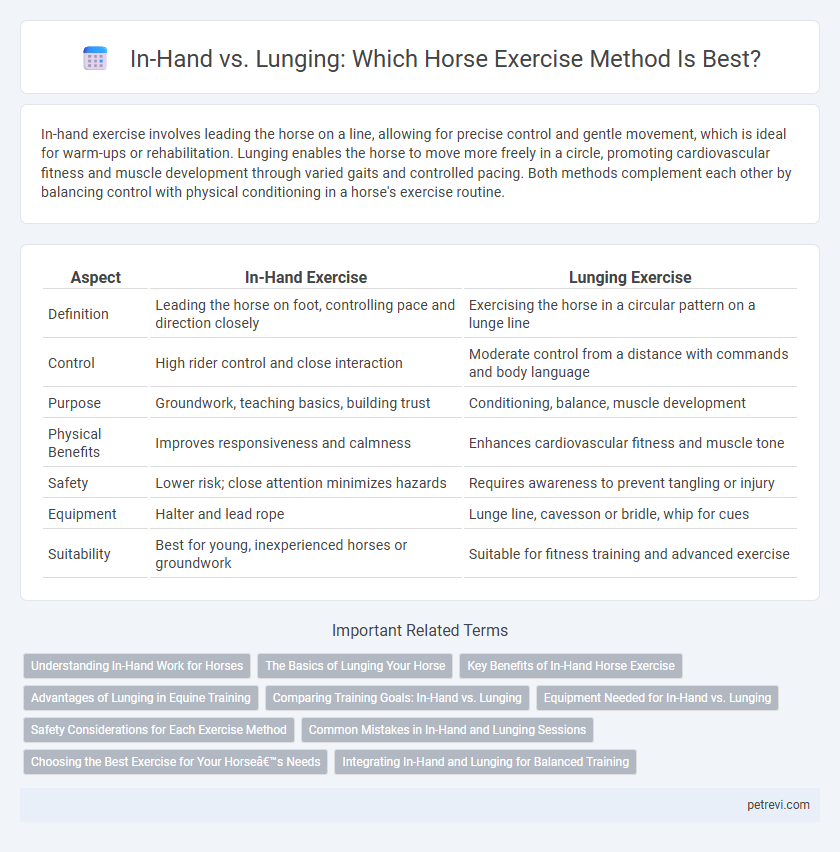In-hand exercise involves leading the horse on a line, allowing for precise control and gentle movement, which is ideal for warm-ups or rehabilitation. Lunging enables the horse to move more freely in a circle, promoting cardiovascular fitness and muscle development through varied gaits and controlled pacing. Both methods complement each other by balancing control with physical conditioning in a horse's exercise routine.
Table of Comparison
| Aspect | In-Hand Exercise | Lunging Exercise |
|---|---|---|
| Definition | Leading the horse on foot, controlling pace and direction closely | Exercising the horse in a circular pattern on a lunge line |
| Control | High rider control and close interaction | Moderate control from a distance with commands and body language |
| Purpose | Groundwork, teaching basics, building trust | Conditioning, balance, muscle development |
| Physical Benefits | Improves responsiveness and calmness | Enhances cardiovascular fitness and muscle tone |
| Safety | Lower risk; close attention minimizes hazards | Requires awareness to prevent tangling or injury |
| Equipment | Halter and lead rope | Lunge line, cavesson or bridle, whip for cues |
| Suitability | Best for young, inexperienced horses or groundwork | Suitable for fitness training and advanced exercise |
Understanding In-Hand Work for Horses
In-hand work for horses involves guiding the horse on foot using a lead rope or reins, focusing on controlled movements and obedience, which enhances the horse's responsiveness and balance. This training method allows for precise communication and helps develop muscle tone, coordination, and trust between horse and handler. Unlike lunging, in-hand work emphasizes subtle cues and direct contact, making it ideal for groundwork and preparing horses for ridden work.
The Basics of Lunging Your Horse
Lunging your horse involves guiding it in a controlled circle on a long lunge line to develop balance, rhythm, and obedience while allowing freedom of movement. Proper lunging requires maintaining consistent rein aids, using appropriate lunging equipment like a cavesson or bridle, and adjusting circle size to match the horse's training level and physical condition. Regular lunging sessions improve muscle tone, flexibility, and responsiveness, serving as a crucial foundation for more advanced ridden work and rehabilitation.
Key Benefits of In-Hand Horse Exercise
In-hand horse exercise enhances precise communication and control between horse and handler, promoting better responsiveness and trust. It supports joint mobility and muscle engagement with low impact, reducing injury risk compared to more strenuous methods. Regular in-hand work also improves balance and coordination, essential for overall equine athletic performance.
Advantages of Lunging in Equine Training
Lunging offers enhanced cardiovascular conditioning and muscle development by allowing horses to move freely in controlled circular patterns, promoting balance and coordination. This exercise method provides comprehensive workout benefits, improving responsiveness to commands and aiding in behavioral management through consistent rhythm and pace. Lunging also allows trainers to assess gait and fitness levels effectively while minimizing strain on the handler.
Comparing Training Goals: In-Hand vs. Lunging
In-hand training emphasizes precise control and direct communication with the horse, enhancing groundwork skills, balance, and responsiveness at the handler's side. Lunging develops aerobic fitness, muscle tone, and impulsion by encouraging the horse to move independently on a large circle, promoting rhythm and relaxation. Choosing between in-hand and lunging depends on training goals: in-hand work refines manners and coordination, while lunging builds physical conditioning and obedience from a distance.
Equipment Needed for In-Hand vs. Lunging
In-hand exercise for horses requires minimal equipment, typically just a sturdy halter and lead rope, allowing close control and direct interaction. Lunging demands more specialized gear including a lunge line, cavesson or bridle, and often side reins or lunging aids to ensure safety and effective communication at a distance. Proper footwear for the handler and a spacious, safe lunge area are essential for optimal lunging sessions.
Safety Considerations for Each Exercise Method
In-hand exercises offer controlled, close-contact interaction, minimizing risks of sudden movements and enhancing rider safety through direct guidance. Lunging involves the horse moving at a distance, requiring clear communication and proper equipment, with increased risk of injury if the horse spooks or the longe line entangles. Prioritizing appropriate protective gear and maintaining attentive supervision are essential safety practices for both in-hand work and lunging sessions.
Common Mistakes in In-Hand and Lunging Sessions
Common mistakes in in-hand horse exercise include improper rein length, causing restricted movement and tension, and inconsistent cues leading to confusion and resistance. During lunging sessions, errors often involve lack of proper equipment fit, excessive use of whip or voice commands, and incorrect circle size causing strain or imbalance. Both methods require precise timing and consistent communication to ensure effective and safe training outcomes.
Choosing the Best Exercise for Your Horse’s Needs
In-hand exercise offers precise control and is ideal for training young or recovering horses by improving balance and obedience through close interaction. Lunging provides cardiovascular conditioning and muscle development while allowing freedom of movement in a controlled environment. Selecting the best exercise depends on your horse's fitness level, training goals, and physical limitations to optimize performance and well-being.
Integrating In-Hand and Lunging for Balanced Training
Integrating in-hand work and lunging creates a balanced training regimen that promotes muscle development, flexibility, and responsiveness in horses. In-hand exercises enhance ground manners and precision, while lunging builds cardiovascular fitness and encourages natural movement. Combining both methods ensures comprehensive conditioning and reduces the risk of overuse injuries by varying intensity and focus.
In-Hand vs Lunging for Horse Exercise Infographic

 petrevi.com
petrevi.com